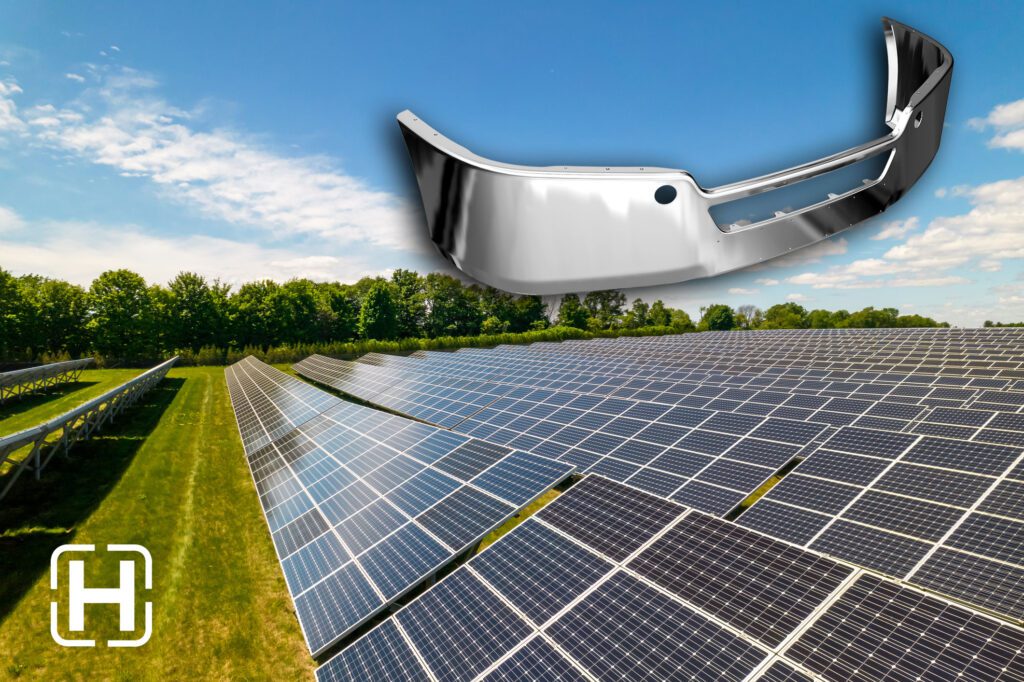Sustainability and decarbonization are now crucial focal points in the heavy-duty trucking sector, impacting both fleet operations and the production of truck components. Hendrickson, a manufacturer known for its suspension systems and components, is making significant strides with the introduction of solar energy at its bumper manufacturing facility in Illinois. This investment marks a transition towards more environmentally friendly and efficient manufacturing processes, as the plant produces over 100,000 bumpers each year for Class 8 trucks and school buses.
Seamless Integration of Solar Power
The installation of a solar farm with over 2,100 solar panels, capable of generating approximately 1.58 megawatt hours annually, might appear to be a complex process. However, as Chris Batsch, General Manager of Specialty Products Bumper at Hendrickson, explains, the implementation was unexpectedly simple. “I was really surprised at how easy it was to integrate this into our facility,” Batsch noted. “We just needed to connect the solar farm to the electrical grid. Our utility provider gives us credit for the surplus energy we generate, which we can use during cloudy days or nighttime.”
This net metering strategy guarantees a consistent energy supply without requiring any changes to operations or existing product lines. The manufacturing of bumpers, which relies heavily on energy-demanding machines such as laser cutters, deep draw presses, robotic welders, and polishing tools, makes solar energy a suitable option to mitigate high electricity usage.
Driving Decarbonization and Industry Collaboration
The move towards renewable energy supports the industry’s broader objectives of lowering carbon emissions. Hendrickson’s initiatives align with the sustainability goals of key OEM partners, such as Daimler Truck North America, Volvo Trucks North America, and PACCAR. “We’re definitely hearing this from our clients,” Batsch explained. “Several of them have established ambitious targets, aiming even for full carbon neutrality in the future. While that’s a significant leap from our present state, by incorporating renewable energy sources like solar, we can align ourselves more closely with their goals.”
The decision to adopt solar energy was heavily influenced by Hendrickson’s Illinois location, which provides advantageous incentives and net metering options. The company also utilized vacant land next to its facility to set up the solar farm, avoiding the high costs associated with rooftop installations while optimizing available space.
The Fleet Perspective: Why It Matters
For those managing fleets and truck equipment, the advantages of sustainable production reach beyond the manufacturing plant. Through investments in renewable energy and low-carbon production techniques, Hendrickson is lessening the environmental footprint of its products while preserving the durability and performance that fleets depend on. “Our clients don’t just want sustainability; it has to be cost-effective and efficient too,” Batsch remarked. “With solar energy, we’re accomplishing both.”
The focus on sustainable practices in metal bumper production is particularly important, as metal components typically have a larger carbon footprint compared to plastic alternatives. Hendrickson is proactively tackling this issue by looking into further initiatives, including low-carbon steel options and even carbon-negative paint technologies. With the costs of commercial solar installations dramatically decreasing over recent years, the timing for renewable energy investment has never been better. “A few years ago, the cost of commercial solar was more than double what it is today. Ten years ago, it was nearly twenty times higher,” Batsch noted. “We’re taking advantage of this timely opportunity to enhance our sustainability initiatives.”
By incorporating solar energy and participating in decarbonization initiatives within the industry, Hendrickson is setting an example for truck component manufacturers by demonstrating how sustainability can be pursued without sacrificing performance. For fleet operators, this equates to having greater access to products that facilitate their own carbon reduction objectives while meeting the reliability and strength requirements for heavy-duty applications. As the concept of sustainability becomes increasingly central to the trucking industry, investments like Hendrickson’s solar-powered manufacturing are leading the way towards a cleaner and more efficient future—one bumper at a time.
Sponsored by Hendrickson


